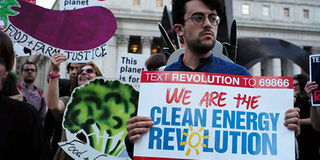What US pulling out of Paris pact means for Kenya, Africa

Environmental activists and supporters display placards during a demonstration in New York on June 1, 2017, to protest US President Donald Trump's decision to pull out of the 195-nation Paris climate accord deal. PHOTO | EWEL SAMAD | AFP
What you need to know:
- The Paris Agreement aims at strengthening the global response to the threat of climate change by keeping a global temperatures below 2 degrees in this century.
United States’ move to withdraw from the Paris Climate Accord is not only a blow to the world’s effort in trying to limit the rising temperatures, but also a hard slap in the face of Kenya and other developing countries that are heavily paying for the sins they did not commit.
On November 4, President Donald Trump’s administration embarked on a yearlong process of formally withdrawing from the Paris Climate Accord.
But this did not come as a surprise as President Trump had indicated his intention to pull out of Paris Climate Accord immediately after ascending to power.
In one of his numerous tweets, President Trump once opined that the concept of global warming was created by and for the Chinese in order to make US manufacturing less competitive.
In a brief statement posted on White House website, the Trump administration says the Paris Climate Accord “unfairly imposes economic burden on American workers, businesses, and taxpayers by US pledges made under the Agreement”.
Some experts in the US who have come out to condemn President Trump’s action argue that America’s withdrawal creates a leadership vacuum that its near-peer competitors like China will be eager to fill strategically and systematically.
MITIGATE EFFECTS
To maintain mantle of leadership in the global arena, they say, the world’s most powerful country needs to reassess its positions on global initiatives like the Paris Climate Accord.
This is due to the fact that China is currently the world’s largest producer of wind and solar energy and the largest investor in green energy projects. It’s home for the world’s six largest solar manufacturing companies.
But the bitter truth is that developing countries stand to lose the most.
The Paris Agreement aims at strengthening the global response to the threat of climate change by keeping a global temperatures below 2 degrees in this century.
In Kenya, for example, a slight rise in temperature above 2 degrees could cause increase in seawater capable of submerging Mombasa County and 17 per cent of coastal areas, according to the Kenya National Climate Change Action Plan (NCCAP) 2018-2022.
Article 9 of the Paris Agreement that entered into force on November 4, 2016, stipulates that developed country Parties such as US, China, Russia, India and Japan, among others, shall provide financial resources to assist developing country parties like Kenya to put in place appropriate financial flows, new technology and capacity building frameworks in line with their own national objectives.
FUNDING
It says that $100 billion (Sh10 trillion) in public and private resources will need to be raised each year from 2020 to finance projects that enable developing countries, which are hit hard by the impacts of climate change such as drought, floods, diseases among other stressors to build resilience.
Kenya is one of the countries that are supposed to benefit from part of the Sh10 trillion funding to build infrastructures that will, for instance, cushion people against the ravaging floods that have claimed about 20 lives in the last two months, and help the country become food secure among other capacities.
United States' withdrawal from the Climate Accord is a hard slap on the face of Kenya and other developing countries because it is the world’s second-biggest emitter of greenhouse gases, behind China, and is by far the largest cumulative greenhouse gas emitter in history.
With US pulling out of the accord, it means that the likelihood of mobilising the required amount is next to impossible.
According to World Bank statistics, every American is responsible for 16.5 tonnes of carbon dioxide.
RESPONSIBILITY
On the other hand, each Kenyan is responsible for 0.3 tonnes of carbon dioxide. The difference is so huge given that Kenya’s population is only 14 per cent of the United State’s.
According to United Nations Framework Convention on Climate Change (UNFCCC), the entire of Africa continent accounts for only between two to three per cent of the world’s carbon dioxide emissions mostly from energy and industrial sources.
Therefore, President Trump should rescind his decision to save the developing countries that are bearing the heaviest burden of climate change impacts despite emitting smaller amount of greenhouse gases.
Mr Onyango, a reporter with Taifa Leo and Daily Nation, is a climate change adaptation master’s student at the University of Nairobi. [email protected]





